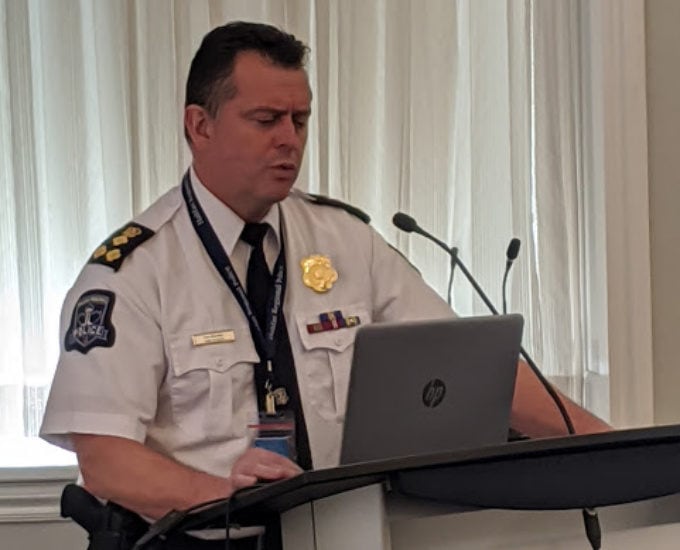
KJIPUKTUK (Halifax) – A recent human rights case, launched by Gyasi Symonds, is a showcase for all that is wrong with the way the Nova Scotia Human Rights Commission (NSHRC) deals with human rights complaints and complainants.
The complaint and the Human Rights Board of Inquiry that followed arose from a January 2017 incident. Symonds, a caseworker at the Department of Social Services who is Black, complained that he was racially profiled and discriminated against because of his race, his sex, and his perceived low income status (he was mistaken for one of his clients), when two white Halifax policemen ticketed him for jaywalking.
Symonds had to represent himself as the NSHRC which permitted the case to go forward, will not represent any individual complainant. The Commission says it represents only general interests of the people in the province.
Symonds, age 41, said that on a cold January morning in 2017, four white female colleagues from his workplace—the MacDonald provincial government building on Gottingen St. –crossed the street to buy coffee at The Nook café. Seconds later, he followed them. Yet only he — none of the white women — was caught for jaywalking.
Symonds testified that two Halifax police officers stopped him in the doorway of The Nook. When Symonds asked if he was under arrest, the officer said no. So Symonds walked past the police into the café to buy his coffee. In effect, Symonds ignored them.
After warning Symonds about jaywalking, the police claimed they started on their foot patrol, walking north to Cornwallis St., and that they turned and saw Symonds once again jaywalk to cross the street. However, Symonds insisted he was rattled by the interaction with the police, so he deliberately crossed at the crosswalk to return to work.
Rather than focus on the allegations of discrimination, much of the human rights hearing focused on whether or not Symonds had been jaywalking. In other words, the technical aspects of the case over-rode the human rights essence of the complaint. This was a serious problem because the respondents were in fact two white policemen, represented by two white female lawyers from the city (Halifax Regional Municipality). At the hearing it was clear that because the respondents were the police the hearing was easily reduced to an issue of law and order – whether Symonds did or did not jaywalk – rather than about the officers’ treatment of him because he was a Black man.
After stopping Symonds at the café, and insisting they saw him jaywalk a second time, the two police officers went into the lobby of the MacDonald building in order to track him down to issue him a ticket.
“The entire time the taller guy [the cop] – his hand was on the gun, it wasn’t in the air, it was close to or on the gun.
”The building Security Guard who testified at the Board of Inquiry
But they did not know his identity, or name. One witness at the hearing, a security guard who was a Black woman, stopped the two policemen as they walked into the building; they demanded to know if she had seen a “Black man with a tuque” come into the lobby. The guard then testified that the officers said they were justified looking for the complainant because, “well, he jaywalked and we were just trying to save his life”.
According to the security guard, she felt the police’s interaction with Symonds was “very disturbing” because the police were “persistent, loud, demanding, short and abrupt“ and “challenged” him. She testified there was yelling by the officers, and “at no time would I call it civil.”
“They [the police] wrote down a ticket and I was relieved they didn’t hurt him, I was glad of that…”
The building Security Guard who testified at the Board of Inquiry
Security guard saw the police being threatening toward Symonds

The security guard said, “I was shaken, yes, because I didn’t know what was going to happen with them being so persistent.” She went on to testify:
“…I do recall… [the police] not using the tone of someone who wants to save someone’s life. They were… like… they were trying to challenge Mr Symonds. Their body movements… he [the taller officer] had his hand back here and was challenging. The entire time the taller guy – his hand was on the gun, it wasn’t in the air, it was close to or on the gun.
“[The police] called down to the station to do a background on [Symonds]. I was in shock at what I was seeing and hearing. They wrote down a ticket and I was relieved they didn’t hurt him – I was glad of that.
“I didn’t understand the behaviour of the police officers at all. I see a lot of people jaywalk all day and the police go by and I see no one being stopped. I tend to lean toward the idea that it’s some kind of bias to walk in the door and single out a Black man in a tuque.”
In their evidence, both police officers insisted the Black security guard had shown them video tape of those who had recently entered the building and that watching the tape, they recognized Symonds. Yet in her testimony, the security guard was adamant there had been no videotape, and she never showed the police any tapes. Instead she had spoken with a department supervisor who had identified Symonds as having just returned from getting coffee.
Why did the police yell, why did they cause a scene in the very busy lobby, why did they bother to follow him across the street to give him a jaywalking ticket?
The imbalance of power between Symonds and the respondents (the police) was breathtaking. The complainant, Symonds, was a single father, and an employee of the provincial government. The police were two beat officers who walked up and down Gottingen Street on foot, who, in their own words, “respond to calls, traffic stops, could be domestics, assaults, thefts, accidents.” These officers carried guns, and had personal power as well as the authority of police. The police, like other white citizens with power, acted as if no Black man with a good job should go unpunished. [1]
Yet this was the reality for Gyasi Symonds, a caseworker who walked across the street that January day. The police were blind to the white women who jaywalked, but Symonds—a Black man – stood out. They described him to the security guard as a “Black man wearing a tuque”. Likely they had first assumed that he was just a poor client of Social Services, not a man with a professional job.
On trial for jaywalking or was it discrimination of a Black man?
The Human Rights Tribunal threatened to descend into, in effect, “trying” Symonds for jaywalking because dealing with race is too scary a problem in Nova Scotia. This is despite the fact that the Halifax police chief had to issue a public apology for street checks to the Black community barely one year ago. This is also despite the fact that six months ago, the crown was forced to drop the trumped-up assault charges against Black mother Santina Rao. It was her who was assaulted and had her wrist broken by Halifax police when they suspected her of shoplifting at Walmart.This is despite the fact that criminologist Scot Wortley reported that Black people are six times more likely to be street checked than white people in Halifax.
The case also underscores the problem of self-representation at human rights tribunals. It’s been said that a carpenter sees every problem as a nail, and by the same token, lawyers may prefer to operate on a technical level rather than on a human rights level. Symonds was not a lawyer yet he had to represent himself. The Human Rights Commission, which accepted his case, sent the Commission’s lawyer to represent the interests of the province. There were also two lawyers who represented HRM, actually the Police. The chair was also a lawyer.
Hiring a lawyer: is that the answer?
Some could say that Symonds could have hired his own lawyer. But the cost of hiring a lawyer for a three-day hearing would have been over $2,000. Symonds would have also had to pay for the lawyer’s preparation time, probably another $2,000. And because costs cannot be assessed in a human rights case, Symonds would never have been able to recover these costs. Symonds, even without engaging a lawyer, still had to miss days of his own paid work to prepare for and attend the hearing.
There are a number of concerns about a complainant who self-represents at a human rights hearing.
First, a normal complainant has little understanding and no experience of court procedures. They don’t know about how to examine or cross-examine witnesses; they don’t know how to research and apply legal precedents to their case; they don’t know legal argument; they don’t know the Nova Scotia Human Rights Act and its regulations; they don’t know when they can give evidence and when they cannot. In a human rights case, respondents frequently have power — they tend to be corporations, or landlords, or employers who can engage lawyers or have in-house counsel. The complainant is too often an individual who could be a minority, a person of colour, a person who is homeless, or without a job, and usually a person with no legal training or familiarity with the courts.
This was clear in the Symonds case. Symonds inadvertently gave evidence as he was examining his own witness (the security guard) and when he cross-examined the police. He made eloquent speeches about the discrimination he faced as a Black man in Halifax.
There is the concern that because Symonds and others who self-represent do not know the legal process, the opposing side can take advantage. This set of circumstances could be both “fair” yet grotesquely “unfair” at the same time.
In any human rights tribunal, every participant has his or her role. Because this is an adversarial forum – there is limited give and take among parties. It is difficult to cross lines – after all there is the lawyer for the respondents, the lawyer for the commission, and the lawyer who is the adjudicator who decides the case. This means that if Symonds had a question or did not know how to proceed, he did not know whom to rely upon for impartial help at the hearing.
Though in Symonds’ case, the chair did give him extra time and latitude, this latitude is dependent on who the chair is, and whether they will “put up with” non-lawyers having to act as lawyers in a hearing.
All three police officers testified they were “aware” of the Wortley Report, but not one had read it
Symonds is a brave person who refused to allow the police to get away with harassment and discrimination. The toll on his family, his job and himself has likely been great. Win or lose, whatever the Board of Inquiry decides will be an anti-climax. After all, even if Symonds wins, what is the remedy for racial bias by the police? It cannot merely be more training, more sensitivity programs, and more education.
The last witness called before the Board was a staff sergeant who had worked for the Halifax Regional Police (HRP) for 31 years – the last three in the training area. He was “aware” of Scot Wortley’s report, but had never read it. The policeman admitted that in the decades since “block” training for police began to 2019 there had been no specific training about discrimination faced by African Nova Scotians. When asked who decided what education was needed, he said the training syllabus came from HRP management, meaning the chief, down through the chain of command.
The 1.4% solution
However, he said in 2020, 20 police officers voluntarily signed up for “Journey to Change” a five-day course oriented to African Nova Scotians and their community. He admitted that it was not mandatory for all 500 police officers, “800 if we include civilians.” According to the staff sergeant, of the 20 who took it, on the program evaluation forms, seven wrote “it was the best course I’ve ever taken.” Those seven represent 1.4% of Halifax Regional police officers.
Judy Haiven is on the steering committee of Equity Watch, an organization that fights discrimination, bullying and racism in the workplace. Contact her at equitywatchns@gmail.com
With a special thanks to our generous donors who make publication of the Nova Scotia Advocate possible.
Subscribe to the Nova Scotia Advocate weekly digest and never miss an article again. It’s free!



